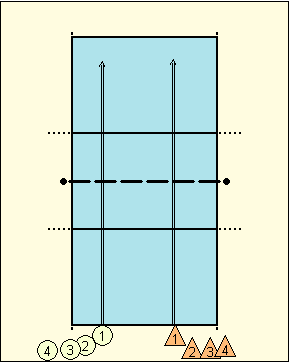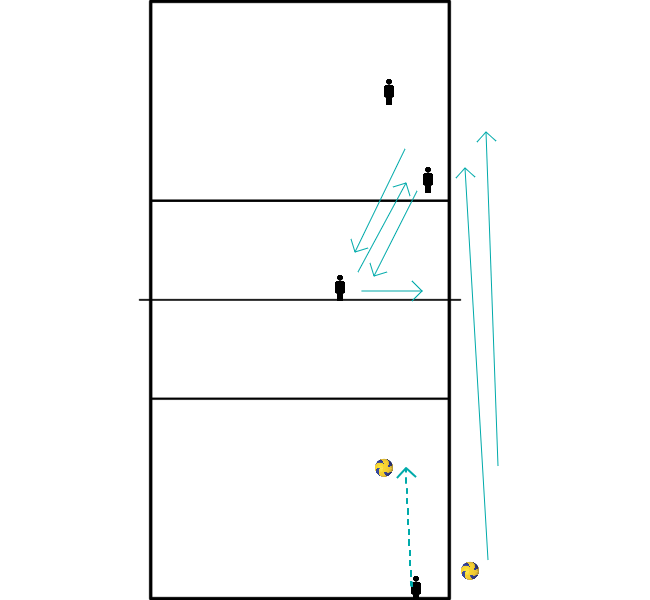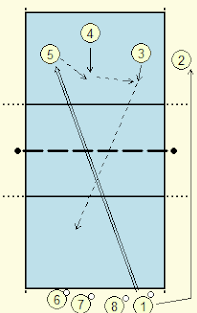Volleyball drills for technique serving

This exercise is fun to do and gives a lot of fun and competition! Relays in general already create competition.
What this exercise also wants to mimic is the stress factor that a serve brings.
The players are divided into equal teams and lined up on the serving area of the same court. The first player of a team serves and retrieves his ball. After the next player is tapped, this one serves, and so on.
It is important for a player to serve quickly, but it must also be flawless, otherwise the ball must be retrieved and served again!
Needs:
- A minimum of 6 players
- As many balls as there are teams
- Extension: extra points to earn by placing hoops in the field.
This exercise is fun to do and gives a lot of fun and competition! Relays in general already create competition.
What this exercise also wants to mimic is the stress factor that a serve brings.
- The players are divided into equal teams and lined up on the serving area of the same court.
- The first player of a team serves and retrieves his ball.
- After the next player is tapped, this one serves, and so on.
It is important for a player to serve quickly, but it must also be flawless, otherwise the ball must be retrieved and served again!
If the teams are small, it is fun to let everyone serve two or three times.
Necessary:
- A minimum of 6 players
- As many balls as there are teams
Click here for the meaning of the symbols.
- three defenders and one playmaker in the field
- three (or more) players stand ready as reserves behind the backline (in front of the three field players)
- rest: serve
- one of the three fielders defends, passes to a random field player, other field players make attacking movement
- only the fielder who has attacked moves up to serve
- one of the reserve players fills the vacant fielder's spot
- Team in line up in field A. In field B 3 blockers and 3 serves.
- Team B serves on team A who come to attack.
- Blockers try to block. Time change.
- The field will be divided in two.
- We play in two groups.
- Per group you have a service-player and a reserve service-player, a playmaker, a striker, two reception-players and a reserve reception-player.
- Servant and attacker stay in position for x-number of balls.
- Service and reception players change places.
- Storage-reception-pass-attack (players change position in their own group).
- After 5 minutes there is a change of position.

- Player serves ball.
- Passing to setter
- Setup gives ball back
- Defense to setup
- setup for attack
- Down ball or free ball is called
- Defence to setup
- quick pass to attacker
extension with block board

- This exercise is fun to do and gives a lot of fun and competition! Relays in general already create competition.
- What this exercise also wants to imitate is the stress factor that a service brings.
- The players are divided into equal teams and lined up on the serving area of the same court. The first player of a team serves and retrieves his ball. After the next player is tapped, this one serves, and so on.
- It is important for a player to serve quickly, but it must also be flawless, otherwise the ball must be retrieved and served again! Group for the first time must reach a multiple of the number of players in the group.
- If the teams are small, it is fun to have everyone serve two or three times.
- Needed:
- Minimum of 6 players
- As many balls as there are teams
- Place a mat at random in each field.
- On 2 sides stand a group to serve.
- Serve on the mat.
- Then run after your ball, tap the wall, and join the line on the other side.
- Who hit the mat the most?
- Players must serve from behind the back line
- Besides technique, communication is also important in volleyball.
- And both aspects also apply to this exercise.
- And reacting adequately to situations which go differently than normal.
- In such an exercise you can see very well how different players are.

- Three players line up to pass (numbers 3, 4 and 5)
- Player 2 stands ready at the side of the same field of play. The other players stand ready with ball to serve on the other side.
- Player 1 serves the ball (and then immediately walks to where player 2 is already standing).
- A player passes the ball. Another player gives a setup. And the third player plays the ball over the net. All three players must play the ball, either a pass, or a setup, or an attack.
- Once the ball is over the net, the players turn: 2 goes into the court (where 3 was first) 3 goes to mid-back, 4 goes to the spot of 5 and 5 goes the serving spot of the other half.
- Then the next player can serve, on the drawing this is player 8. Etc.
Necessary:
- 4 balls
- 7-8 players
- Players face each other at the net
- They take turns to play a technical attack over the net.
- Each time, they take a step backwards until the technical attack evolves into a serve.
- If the ball goes awry : start again from the beginning.
Divide children into 2 different groups.
Children must save. In case of an error (outside, in the net, foot fault) the children must sit in the opposite field. Their own team can get the children free again by passing to them. If the children can catch the ball without moving from their spot, they can rejoin the game. A team loses when everyone is on the opposite side of the field.

This exercise is fun to do and gives a lot of fun and competition! Relays in general already create competition.
What this exercise also wants to mimic is the stress factor that a serve brings.
The players are divided into equal teams and lined up on the serving area of the same court. The first player of a team serves and retrieves his ball. After the next player has been tapped, this one serves and so on.
Only when the ball lands on 1 of the 4 mats the point is counted. It is not allowed to hit the same mat twice in a row. The team that hits the mat first, a multiple of 3 of the number of players in the team, wins.
It is important for a player to serve quickly, but it must also be flawless, otherwise the ball must be retrieved and served again!
If the teams are small, it is fun to have everyone serve two or three times.
Necessary:
- A minimum of 6 players
- As many balls as there are teams







